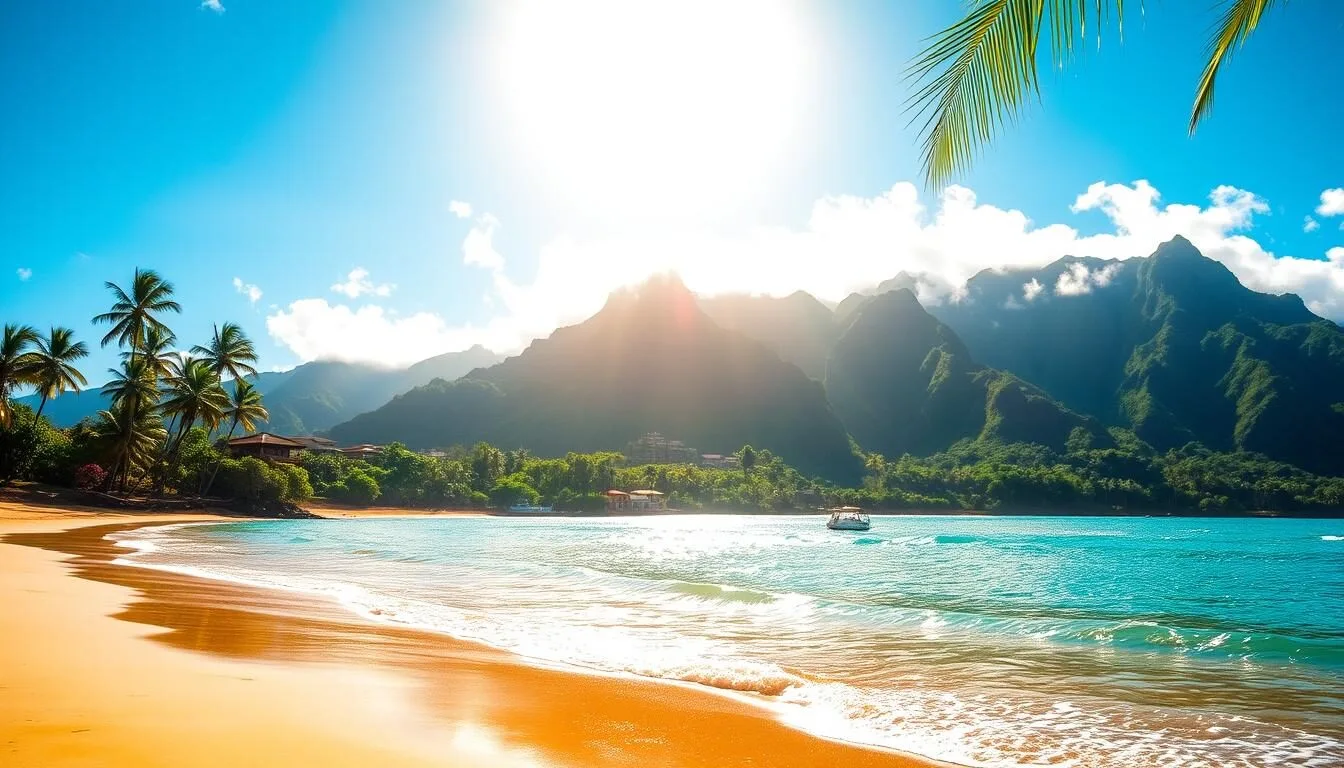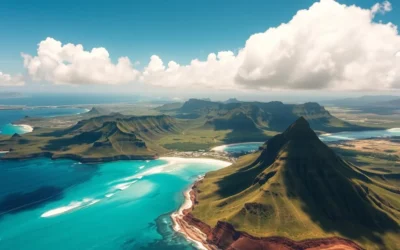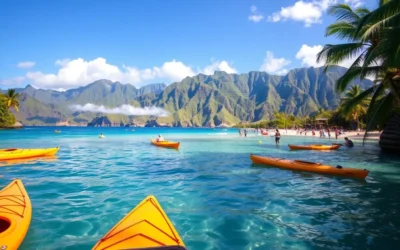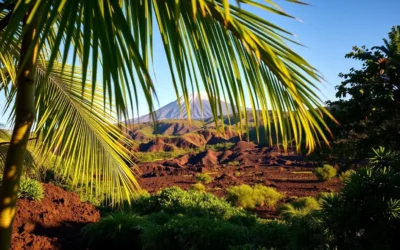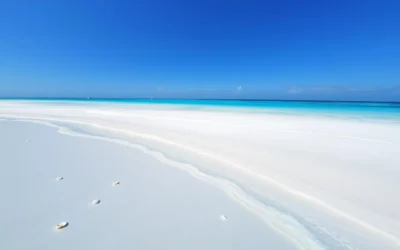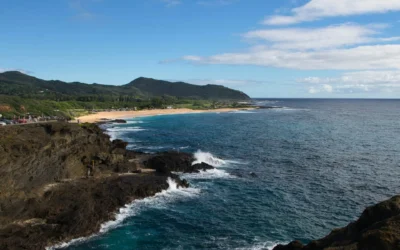✓ Accommodations ✓ Flights ✓ Rental Cars ✓ Tours & Activities
Imagine escaping to a paradise where warm sunshine and gentle breezes greet you year-round. You’re planning a trip to Hawaii, but you’re unsure when to go. With its unique weather patterns, crowd levels, and pricing fluctuations, timing is everything to maximize your Hawaiian experience.
The best time to visit Hawaii depends on your priorities: weather comfort, budget considerations, or specific seasonal activities. With minor temperature fluctuations between seasons, Hawaii offers a desirable “warm, eternal spring” climate year-round. Understanding the nuances of Hawaii’s climate, tourist seasons, and special events will help you make an informed decision about the best time for your vacation.
By considering these factors, you can plan a weather-savvy trip that suits your preferences and makes the most of your time in this island paradise.
Understanding Hawaii’s Year-Round Climate
The unique geography of Hawaii creates a variety of microclimates across the islands. This diversity is a result of the islands’ mountainous landscapes and their exposure to trade winds, which significantly influence temperature and rainfall patterns.
Temperature Patterns Across the Islands
Temperatures in Hawaii remain relatively consistent throughout the year, with average highs ranging from 78°F to 88°F (25°C to 31°C). The temperature varies with elevation, with higher areas being cooler. You can expect a pleasant climate year-round, making Hawaii island an ideal destination for sun-seekers.
Rainfall and Microclimates
Hawaii’s rainfall patterns create dramatic microclimates, with some areas being among the wettest on earth while others remain desert-like, often within just a few miles of each other. The windward sides of the islands receive more rainfall due to orographic rainfall patterns. Most resort areas are located on the leeward sides, ensuring sunny conditions. You should be aware that the rainy season typically occurs during the winter months, from mid-December to mid-April.
When planning your trip, consider that the winter months see slightly higher rainfall across all islands, though showers are usually brief. Understanding these patterns can help you decide the best time visit based on your preferences. For instance, if you prefer lush landscapes, traveling during the winter might be ideal, as the rain makes everything extra green and lush.
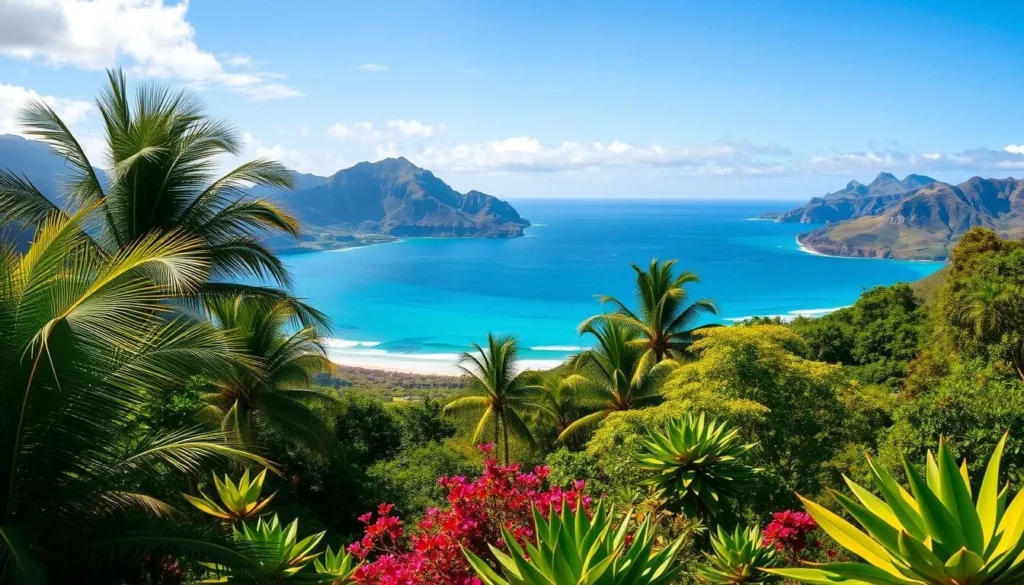
By understanding Hawaii’s climate and microclimates, you can better plan your activities and make the most of your trip. Whether you’re looking to enjoy beach activities or explore lush rainforests, knowing what to expect can enhance your experience.
Winter in Hawaii: December to February
You might be surprised to find that winter in Hawaii is not just about escaping cold weather, but also experiencing the islands’ rich culture. This season, which spans from December to February, brings a unique blend of cultural celebrations, exciting events, and pleasant weather conditions.
Weather Expectations and Ocean Conditions
During the winter months, Hawaii experiences a slight drop in temperature, but the weather remains mild compared to many other parts of the world. Ocean conditions can be rougher due to northern swells, making it a great time for surfers. However, this might not be ideal for all water activities.
Whale Watching Season
Winter is the peak season for whale watching in Hawaii. Humpback whales migrate to Hawaiian waters to mate and give birth, offering spectacular viewing opportunities. You can take guided tours to get up close to these magnificent creatures in their natural habitat.
Holiday Crowds and Pricing Considerations
Winter is a popular time to visit Hawaii, especially around the holiday season. Expect larger crowds and higher prices for accommodations and tourist services. Planning ahead can help you navigate these challenges and make the most of your trip.
Winter Events and Festivals
Hawaii’s winter calendar is packed with cultural events and festivals. You can enjoy the Waimea Ocean Film Festival, the Mitsubishi Electric Championship at Hualalai, and the Panaewa Stampede Festival, among others. These events showcase the islands’ diverse cultural influences and offer a unique experience for visitors. The Waimea Cherry Blossom Heritage Festival is another highlight, celebrating Japanese cultural traditions.
Spring in Hawaii: March to May
As winter fades, spring emerges in Hawaii, bringing a unique blend of pleasant weather and exciting activities. This season is characterized by mild temperatures, decreased rainfall, and lush landscapes, making it an ideal time to explore the islands.
Weather Transition and Rainfall Patterns
During the spring, Hawaii experiences a transition in weather patterns. March and April typically see a decrease in rainfall, leading to clearer skies and more favorable conditions for outdoor activities. By May, the weather is usually warm and sunny, with average high temperatures ranging from 78°F to 85°F across the islands.
The Merrie Monarch Festival and Cultural Celebrations
Spring in Hawaii is also a time for cultural celebrations, with the Merrie Monarch Festival being a highlight. This annual event, held in Hilo on the Big Island, honors King Kamehameha I and features traditional Hawaiian music, dance, and art. It’s a great opportunity to experience the rich cultural heritage of Hawaii.
Spring Break Impact on Crowds and Prices
Spring break, typically occurring in March or April, can impact crowds and prices in Hawaii. Popular destinations and accommodations may see an increase in visitors, leading to higher prices. However, visiting during the shoulder season (April to May) can offer a more relaxed experience and better value.
Ideal Spring Activities
Spring is an excellent time for various activities in Hawaii, including hiking, snorkeling, and whale watching. The ‘Au’au Channel between Maui, Molokai, and Lanai is a prime spot for observing humpback whales. For snorkeling, locations like Molokini Crater, Kealakekua Bay, and Hanauma Bay offer exceptional visibility and diverse marine life.
| Activity | Best Location | Time |
|---|---|---|
| Snorkeling | Molokini Crater, Maui | April to May |
| Whale Watching | ‘Au’au Channel, Maui | April to early May |
| Hiking | Various trails across the islands | March to May |
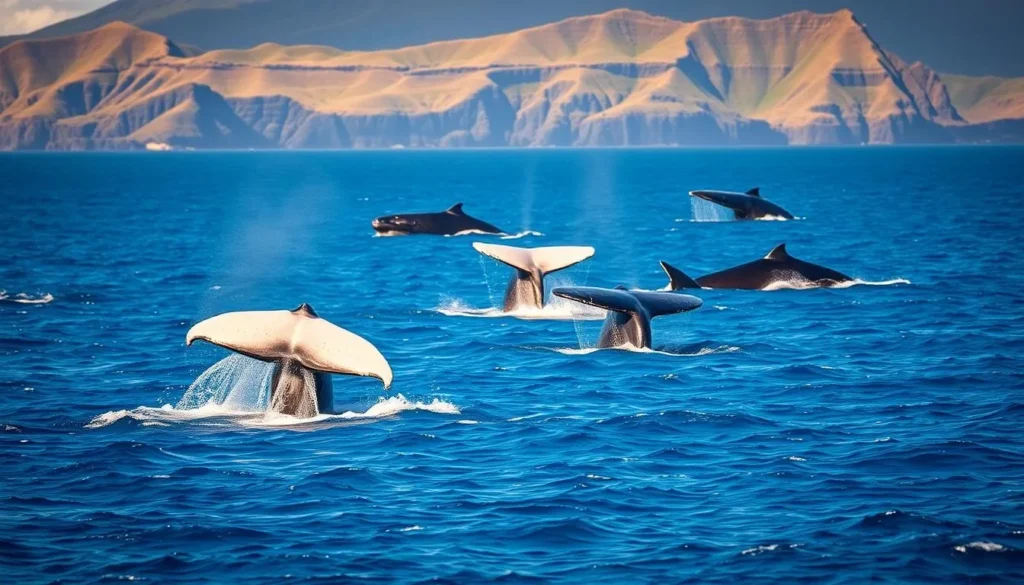
Summer in Hawaii: June to August
Summer in Hawaii, spanning from June to August, brings with it a unique blend of cultural celebrations and outdoor adventures. The warm weather sets the stage for a variety of exciting events and activities across the islands.
Peak Temperatures and Water Conditions
During the summer months, Hawaii experiences peak temperatures, making it ideal for water activities such as surfing, snorkeling, and diving. The ocean conditions are generally calm, with warm waters perfect for enjoying Hawaii’s beautiful beaches.
Family Vacation Season and Crowd Levels
Summer is considered peak tourist season, with families on vacation contributing to higher crowd levels at popular destinations. Visitors can expect bustling beaches and a lively atmosphere at resorts and cultural events.
Summer Pricing Trends
Prices for accommodations and tourist activities tend to be higher during the summer due to increased demand. Planning ahead can help mitigate some of these costs.
Summer Events and Festivals
Summer in Hawaii is filled with numerous events, including the Hawaiian International Billfish Tournament and the Don the Beachcomber Mai Tai Festival. Other highlights include King Kamehameha Day celebrations and the Prince Lot Hula Festival.
| Event | Location | Description |
|---|---|---|
| Hawaiian International Billfish Tournament | Kona, Hawaii Island | A prestigious sport fishing tournament attracting anglers worldwide. |
| Don the Beachcomber Mai Tai Festival | Kailua-Kona | A competition where bartenders vie for the “World’s Best Mai Tai.” |

Fall in Hawaii: September to November
With the arrival of fall, Hawaii’s landscape and atmosphere undergo a subtle yet invigorating transformation. The islands continue to offer a tropical paradise experience, but with fewer crowds and more comfortable temperatures.
Weather Patterns and Hurricane Season
During the fall, Hawaii experiences a transition in weather patterns. Although it’s still within hurricane season, the likelihood of a hurricane impacting the islands is relatively low. Temperatures remain warm, making it an ideal time for outdoor activities.
The Sweet Spot: Lower Crowds and Better Deals
Fall is considered a great time to visit Hawaii if you’re looking for a more relaxed atmosphere and potentially better deals on accommodations and activities. With the summer crowds dissipating, you can enjoy a more peaceful vacation.
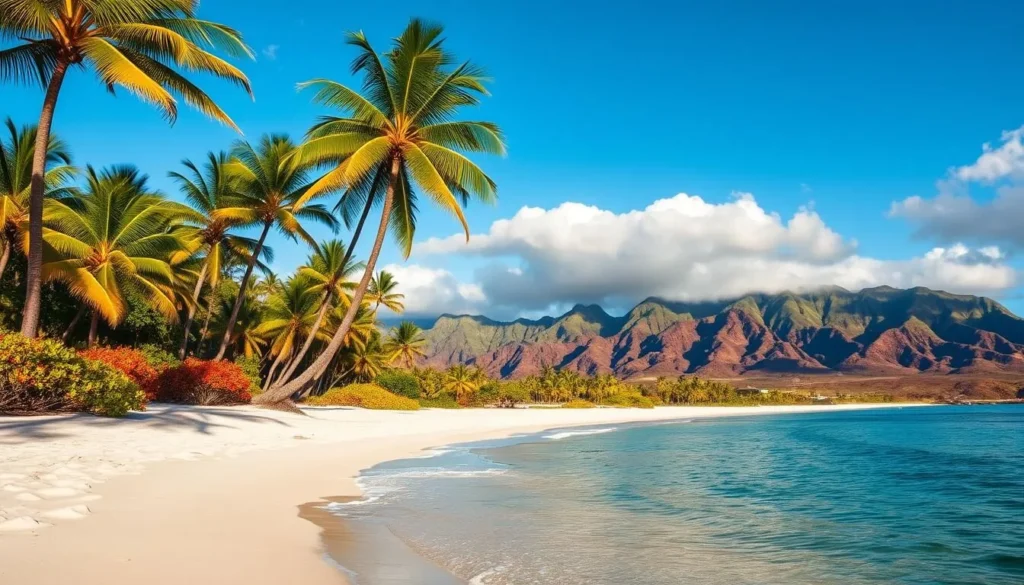
Fall Events Including the Ironman Triathlon
Fall in Hawaii is marked by exciting events, including the prestigious Ironman Triathlon held on the Big Island. This event attracts athletes and spectators from around the world, adding to the islands’ vibrant atmosphere.
Island-Specific Fall Highlights
Each island offers unique experiences during the fall. For instance, the Big Island’s Kona coffee harvest is in full swing, while Maui’s Upcountry region enjoys ideal temperatures for exploring Haleakalā. Kauai’s North Shore becomes more accessible, and Oahu’s North Shore starts to see the arrival of big waves.
| Island | Fall Highlights |
|---|---|
| Big Island | Kona coffee harvest, farm tours |
| Maui | Exploring Haleakalā, lavender farms |
| Kauai | Napali Coast, Kalalau Trail hiking |
| Oahu | North Shore big wave season |
Whether you’re looking for a relaxing getaway or an action-packed adventure, Hawaii’s islands in the fall offer something for everyone. Consider visiting the side island for a more secluded experience, or explore the various things to do on each island to make the most of your trip to this beautiful place.
Hawaii, United States: Best Months for a Weather-Savvy Trip
If you’re planning a trip to Hawaii, understanding the best months to visit can make all the difference in your experience. Hawaii’s climate is pleasant year-round, but the time of year can significantly impact your travel costs, crowd levels, and the activities you can enjoy.
April to June: Perfect Balance of Weather and Value
The period from April to June offers a great balance of good weather and value for money. The weather is warm and sunny, with gentle breezes, making it ideal for outdoor activities. Additionally, accommodation rates and airfares are relatively lower compared to the peak summer months, making it an attractive time for budget-conscious travelers.
September to October: The Insider’s Secret
September and October are considered the insider’s secret for visiting Hawaii. The summer crowds have dissipated, and the weather remains warm and pleasant. This period is also characterized by lower prices for accommodations and flights, making it an excellent time for those looking for a more relaxed and affordable vacation.
Choosing Based on Your Travel Priorities
When deciding the best time to visit Hawaii, consider your travel priorities. If you’re interested in whale watching, the winter months (December to April) are ideal. For surfers, the period from November to March offers the most dramatic wave action. Cultural enthusiasts might prefer planning around major festivals like the Merrie Monarch Festival in April or the Aloha Festivals in September.
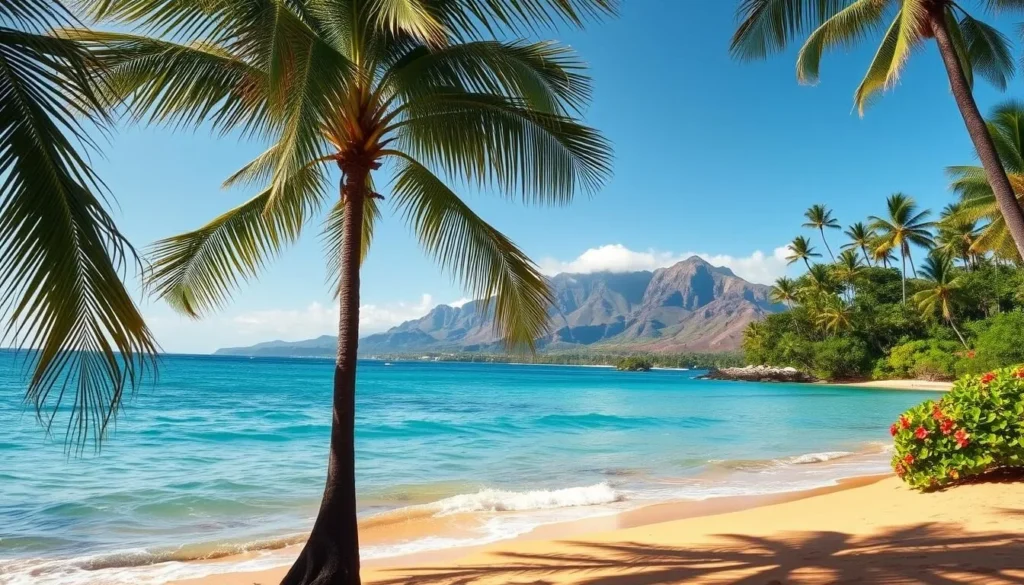
Island-Specific Considerations
Hawaii’s islands are as diverse as they are beautiful, each with its own weather patterns and crowd levels. Understanding these differences is key to planning your trip.
Big Island Weather Variations
The Big Island boasts a range of climates due to its size and varied landscapes. You can experience tropical weather on one side of the island and temperate or even snowy conditions on the other, depending on the elevation.
Maui’s Microclimates
Maui is known for its distinct microclimates, with the west coast generally being drier and sunnier than the east. The island’s mountainous regions can create dramatic weather variations, making it essential to check local forecasts.
Oahu’s Crowd Patterns
Oahu, home to Honolulu and Waikiki Beach, is one of the most crowded islands. If you’re looking for a vibrant atmosphere, Oahu is ideal. However, if you prefer fewer crowds, consider visiting during the shoulder season.
Kauai: The Garden Isle’s Unique Weather
Kauai is known for its lush landscapes and varied rainfall. The North Shore receives significantly more precipitation than the South Shore, especially during winter. The island’s compact size means weather can vary dramatically over short distances.
| Island | Weather Characteristics | Crowd Levels |
|---|---|---|
| Big Island | Diverse climates, tropical to temperate | Variable, less crowded than Oahu |
| Maui | Distinct microclimates, west coast drier | Popular, but less crowded than Oahu |
| Oahu | Tropical, with a dry summer season | Highly crowded, especially around Waikiki |
| Kauai | Lush, with significant rainfall variations | Less crowded, ideal for a peaceful vacation |
By understanding the unique characteristics of each island, you can choose the best time to visit based on your preferences for weather and crowd levels, making your trip to Hawaii truly unforgettable.
Conclusion: Planning Your Perfect Hawaiian Getaway
Hawaii’s diverse islands and microclimates mean that the best time to visit depends on what you’re looking for in your Hawaiian getaway. While Hawaii truly offers excellent conditions year-round, understanding the nuances of its seasonal patterns allows you to align your visit with your specific priorities and preferences.
For most travelers, the shoulder seasons of April-June and September-October offer the most favorable conditions across all islands, providing an optimal balance of weather, value, and experiences. However, specific interests may dictate different timing, such as whale watching from January to March or experiencing the prestigious Merrie Monarch hula competition in April.
Regardless of when you visit, embracing the spirit of aloha and maintaining flexibility with outdoor activities will ensure a memorable Hawaiian experience. With its rich cultural heritage and breathtaking natural beauty, Hawaii is a destination that promises an unforgettable trip, making it the perfect time to visit Hawaii whenever you can.
The above is subject to change.
Check back often to TRAVEL.COM for the latest travel tips and deals.
